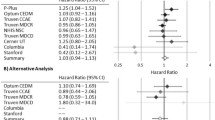Abstract
Two recent papers that examined the association between oral bisphosphonates and the risk of esophageal cancer reported seemingly discrepant findings, despite both studies using data from the UK General Practice Research Database, from similar time periods. Each paper set out brief conclusions within their abstracts, generating two opposing impressions: that the risk of incident esophageal cancer is not significantly increased with bisphosphonate use, or that the risk is increased when bisphosphonates have been prescribed ten or more times, or for longer than 5 years. Of course, the latter conclusion was more widely reported in the popular press, and with patients arriving at the clinic wanting to discuss the reports, clinicians must be able to interpret the existing evidence correctly. In this article we discuss important methodological issues regarding the two observational studies, define areas of consensus and discrepancy, examine possible bias and confounding, and condense the results into a clinically useful summary.
This is a preview of subscription content, access via your institution
Access options
Subscribe to this journal
Receive 12 print issues and online access
$209.00 per year
only $17.42 per issue
Buy this article
- Purchase on Springer Link
- Instant access to full article PDF
Prices may be subject to local taxes which are calculated during checkout
Similar content being viewed by others
References
Cardwell, C. R., Abnet, C. C., Cantwell, M. M. & Murray, L. J. Exposure to oral bisphosphonates and risk of esophageal cancer. JAMA 304, 657–663 (2010).
Green, J. et al. Oral bisphosphonates and risk of cancer of oesophagus, stomach, and colorectum: case–control analysis within a UK primary care cohort. BMJ 341, c4444 (2010).
Watson, J., Wise, L. & Green, J. Prescribing of hormone therapy for menopause, tibolone, and bisphosphonates in women in the UK between 1991 and 2005. Eur. J. Clin. Pharmacol. 63, 843–849 (2007).
Lassen, A., Hallas, J. & de Muckadell, O. B. Esophagitis: incidence and risk of esophageal adenocarcinoma—a population-based cohort study. Am. J. Gastroenterol. 101, 1193–1199 (2006).
Daily Mail reporter. Drugs to fight bone thinning 'double the risk of cancer'. Daily Mail (London) (3 Sep. 2010).
Askling, J. & Dixon, W. The safety of anti-tumour necrosis factor therapy in rheumatoid arthritis. Curr. Opin. Rheumatol. 20, 138–144 (2008).
Meier, C. R., Schlienger, R. G., Kraenzlin, M. E., Schlegel, B. & Jick, H. HMG-CoA reductase inhibitors and the risk of fractures. JAMA 283, 3205–3210 (2000).
van Staa, T. P., Wegman, S., de Vries, F., Leufkens, B. & Cooper, C. Use of statins and risk of fractures. JAMA 285, 1850–1855 (2001).
de Vries, F. de Vries, C., Cooper, C., Leufkens, B. & van Staa, T. P. Reanalysis of two studies with contrasting results on the association between statin use and fracture risk: the General Practice Research Database. Int. J. Epidemiol. 35, 1301–1308 (2006).
Solomon, D. H., Rekedal, L. & Cadarette, S. M. Osteoporosis treatments and adverse events. Curr. Opin. Rheumatol. 21, 363–368 (2009).
Herxheimer, A. Communicating with patients about harms and risks. PLoS Med. 2, e42 (2005).
Gigerenzer, G. Reckoning with risk: Learning to live with uncertainty (Penguin Books, London, 2003).
Calman, K. C. & Royston, G. Risk language and dialects. BMJ 315, 939–942 (1997).
Black, D. M. et al. Bisphosphonates and fractures of the subtrochanteric or diaphyseal femur. N. Engl. J. Med. 362, 1761–1771 (2010).
Gallagher, A. M., Rietbrock, S., Olson, M. & van Staa, T. P. Fracture outcomes related to persistence and compliance with oral bisphosphonates. J. Bone Miner. Res. 23, 1569–1575 (2008).
Abrahamsen, B., Eiken, P. & Brixen, K. Atrial fibrillation in fracture patients treated with oral bisphosphonates. J. Intern. Med. 265, 581–592 (2009).
Kim, S. Y., Kim, M. J., Cadarette, S. M. & Solomon D. H. Bisphosphonates and risk of atrial fibrillation: a meta-analysis. Arthritis Res. Ther. 12, R30 (2010).
Loke Y. K., Jeevanantham V. & Singh S. Bisphosphonates and atrial fibrillation: systematic review and meta-analysis. Drug Saf. 32, 219–228 (2009).
Acknowledgements
W. G. Dixon is supported by an MRC Clinician Scientist Fellowship (G0902272), and D. H. Solomon receives salary support from the National Institutes of Health of the USA (AR055989).
Author information
Authors and Affiliations
Contributions
W. G. Dixon and D. H. Solomon contributed equally to all aspects of the preparation of this manuscript.
Corresponding author
Ethics declarations
Competing interests
D. H. Solomon receives a research grant from Amgen for the study of rheumatoid arthritis. W. G. Dixon declares no competing interests.
Rights and permissions
About this article
Cite this article
Dixon, W., Solomon, D. Bisphosphonates and esophageal cancer—a pathway through the confusion. Nat Rev Rheumatol 7, 369–372 (2011). https://doi.org/10.1038/nrrheum.2011.60
Published:
Issue Date:
DOI: https://doi.org/10.1038/nrrheum.2011.60
This article is cited by
-
Exposure to oral bisphosphonates and risk of gastrointestinal cancer
Osteoporosis International (2020)




